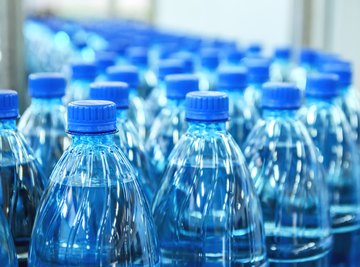
When it comes to beverage storage containers, people can buy either a plastic bottle or an aluminum can. These options may seem similar on the surface--both hold liquids, after all. Yet major differences between the aluminum can and the plastic bottle can affect the health of both people and the environment.
Amount Held
A standard plastic bottle holds 20 fluid oz. A standard aluminum can holds 12 fluid oz. An aluminum can contains one serving. For plastic bottles, servings are smaller (generally 8 oz.), so a bottle usually has 2.5 servings. This can be true even if the exact same product is used. Coca Cola and Pepsi, for example, are available in both cans and bottles. The larger servings suggested for cans may have to do with the fact that cans cannot be resealed.
Advantage of Aluminum Cans
Aluminum cans do not contain bisophenol A (BPA), found in plastic bottles. This chemical has come under scrutiny due to a possible link to health risks that might include cancer. Most plastic bottle manufacturers insist that plastic bottles are safe, but consumer advocate groups support legislation that would ensure the removal of BPA from plastic products. The success of consumer groups can be seen in the increasing number of manufacturers who voluntarily are removing BPA from baby bottles.
Advantage of Plastic Bottles
You can reseal plastic bottles by putting the bottle lid back on. Doing this prevents contaminants getting into the drink, increases portability and preserves freshness. Cans cannot be resealed once they are opened, so the entire contents of the can have to be used at one time or placed into a storage container.
Materials
Plastic bottles and aluminum cans are made using different materials. Plastic bottles require large amounts of petroleum to produce. Aluminum cans require refined bauxite ore.
Environmental Considerations
Both plastic bottles and aluminum cans can be recycled. However, only 10 percent of bottles are recycled when compared to 50 percent of cans. Cans also are more efficient to recycle than bottles. Once the aluminum has been produced, it can be recycled over and over again. Bottles use more energy because they require the use of petroleum, a a limited resource that has demands in other industries. Both cans and bottles, if not recycled, may take more than 400 years to decompose in a landfill--scientists have been able to estimate this decomposition rate because they have studied the molecular structure and bonds of plastics and cans.
References
Resources
About the Author
Wanda Thibodeaux is a freelance writer and editor based in Eagan, Minn. She has been published in both print and Web publications and has written on everything from fly fishing to parenting. She currently works through her business website, Takingdictation.com, which functions globally and welcomes new clients.
